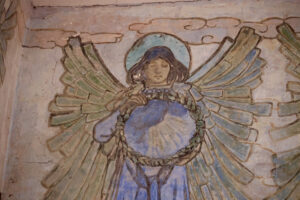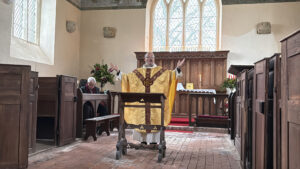Just a few miles from Rye is the tiny settlement of East Guldeford. There are some cottages and farms, all home to fewer than 100 people. (In 1676 we know that was just 35.) The place takes its name from the Guldeford family, who were descended from Sir John Guldeford, who was Comptroller of the Household to King Edward IV.
During the Wars of the Roses both Sir John and his son, Sir Richard, were supporters of the claim to the English throne by Henry Tudor the Earl of Richmond, and for this were attainted by parliament. This meant that they were found guilty without being tried in a court of law and their property was forfeited to the crown. Henry became King Henry VII in 1485 after defeating King Richard III at the Battle of Bosworth, and he restored the Guldeford lands to them.
Prior to the 15th century there had, in reality, been very little in the area. It was just salt water marshes with the local industry being salt production. At the end of that century Sir Richard Guldeford reclaimed much of the land and ordered the construction of a sea wall. By draining away the salty water a rich farmland was established.

In 1505 Sir Richard commissioned the building of a very unusual church – it is said to look more like a barn than a church. It was consecrated by Richard Fitzjames the Bishop of Chichester on September 20 1505. Unique amongst churches on Romney Marsh it is built of brick, very much in the style of the Low Countries, with two gabled roofs and a little bell tower between them. Inside, the plain interior is relieved by a frieze of seraphim and musical instruments. The font was probably made in France during the 12th century and so obviously came from another church. A rare survival is the double-decker pulpit and box pews.
You can read more about the frieze, which was rededicated last year, in this Rye News article.
Writing in 1924, Arthur Beckett tells us in his lovely book ‘The Wonderful Weald’ about a 19th century vicar, not a local man, who was standing in temporarily for the incumbent. Before the service began, the parish clerk asked him if it would be acceptable to do his ‘praiching in the reading desk, for my old hen has made her nest in the pulpit, and as she is sitting, I shouldn’t like to have her disturbed.’ We know that in 1872, the living was combined with Playden with the annual stiped worth £450 a year. We also know that in the same year there were 29 houses valued at £7, 423 with a population of 152.

What an isolated place it must have been in those days. That all changed on April 25 1893 when a long planned road from Rye, together with a bridge over the River Rother, was opened by The Honourable Miss Dodson, daughter of Lord and Lady Monk-Bretton. Her Ladyship was intending to take the ceremony herself but was unwell, so just Miss Dodson and her father attended. The ceremony, which was followed by a lunch and speeches for the great and good at The George Hotel in Rye, was written up in the South Eastern Advertiser on April 29 and 69 column inches. There must have been very little other news at the time!
A bridge had been planned since at least 1790 but failed to materialise because of objections from the owners of adjacent land. The Scots Float Sluice was constructed in 1736 making it possible to cross the river and go on to Rye via a lane. A road was built by local landowner Jeremiah Curteis in 1804, passing under a cliff and thence to Rye. The Military Road of 1806 followed the same route. The road ran via
Brooks Bridge to Scots Float Sluice and in 1808 Mr Curteis set up a tollgate.
H P Clark of Rye, a printer with well-known strong views, wrote and printed a verse called ‘Childe – Curteis’ Gate Dedicated to Fair Play inveighing against the imposition of tolls. The debate continued for years and in 1880 George Henbrey from Church Farm wrote a letter to E B H Curteis about a new bridge. The response was direct and uncompromising! ‘I do not take the proposition in your letter with much serious consideration. I grant it would benefit a few farms like yours, and Camber & Broomhill but the expense alone will beat you. I will use my utmost endeavours to prevent it crossing my land. How will you be able to pay £6,000 to Major R. Curteis for compensation for his gate?’
After much debate, often acrimonious, the decision to commission a bridge and road to Rye was taken by the local council on April 25 1893. It was to cost £4,390. Rye Council would stump up £1,000, the county council just £500, with the balance from public subscriptions. It made travel much easier, but the local population is now less than in the 19th century.
Image Credits: Kt bruce .




East Guldeford church looks fascinating. Is it open during the day
The information about it says that it is normally open, but if any questions contact the church wardens
Contact Information:
Mrs. Annie Thorne: anniebakersheepfarm@gmail.com, 07808211228.
Mr. Richard Baker: rhbakerandson@btinternet.com, 07960175918.
I was baptised at Eas Guldford Church. I wonder if there is a list of baptisms in the church.
There should be parish records. Maybe check with the church wardens? They probably aren’t kept on display.